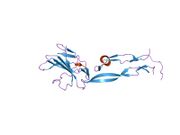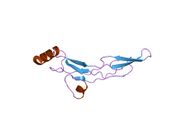Biology:Transforming growth factor, beta 3
Transforming growth factor beta-3 is a protein that in humans is encoded by the TGFB3 gene.[1][2]
It is a type of protein, known as a cytokine, which is involved in cell differentiation, embryogenesis and development. It belongs to a large family of cytokines called the Transforming growth factor beta superfamily, which includes the TGF-β family, Bone morphogenetic proteins (BMPs), growth and differentiation factors (GDFs), inhibins and activins.[3]
TGF-β3 is believed to regulate molecules involved in cellular adhesion and extracellular matrix (ECM) formation during the process of palate development. Without TGF-β3, mammals develop a deformity known as a cleft palate.[4][5] This is caused by failure of epithelial cells in both sides of the developing palate to fuse. TGF-β3 also plays an essential role in controlling the development of lungs in mammals, by also regulating cell adhesion and ECM formation in this tissue,[6] and controls wound healing by regulating the movements of epidermal and dermal cells in injured skin.[1]
Interactions
Transforming growth factor, beta 3 has been shown to interact with TGF beta receptor 2.[7][8][9][10]
Clinical research
After successful phase I/II trials,[11] human recombinant TGF-β3 (Avotermin, planned trade name Juvista) failed in Phase III trials.[12]
References
- ↑ Jump up to: 1.0 1.1 "A "traffic control" role for TGFbeta3: orchestrating dermal and epidermal cell motility during wound healing". The Journal of Cell Biology 172 (7): 1093–105. Mar 2006. doi:10.1083/jcb.200507111. PMID 16549496.
- ↑ "Entrez Gene: TGFB3 transforming growth factor, beta 3". https://www.ncbi.nlm.nih.gov/sites/entrez?Db=gene&Cmd=ShowDetailView&TermToSearch=7043.
- ↑ "Transforming growth factor-beta-related proteins: an ancestral and widespread superfamily of cytokines in metazoans". Developmental and Comparative Immunology 28 (5): 461–85. May 2004. doi:10.1016/j.dci.2003.09.007. PMID 15062644.
- ↑ "Pathogenesis of cleft palate in TGF-beta3 knockout mice". Development 126 (17): 3869–79. Sep 1999. doi:10.1242/dev.126.17.3869. PMID 10433915.
- ↑ "Tgf-beta3-induced palatal fusion is mediated by Alk-5/Smad pathway". Developmental Biology 266 (1): 96–108. Feb 2004. doi:10.1016/j.ydbio.2003.10.007. PMID 14729481.
- ↑ "Abnormal lung development and cleft palate in mice lacking TGF-beta 3 indicates defects of epithelial-mesenchymal interaction". Nature Genetics 11 (4): 415–21. Dec 1995. doi:10.1038/ng1295-415. PMID 7493022.
- ↑ "Transforming growth factor-beta (TGF-beta) binding to the extracellular domain of the type II TGF-beta receptor: receptor capture on a biosensor surface using a new coiled-coil capture system demonstrates that avidity contributes significantly to high affinity binding". Journal of Molecular Biology 328 (5): 1173–83. May 2003. doi:10.1016/S0022-2836(03)00360-7. PMID 12729750.
- ↑ "Crystal structure of the human TbetaR2 ectodomain--TGF-beta3 complex". Nature Structural Biology 9 (3): 203–8. Mar 2002. doi:10.1038/nsb766. PMID 11850637.
- ↑ "Endoglin is an accessory protein that interacts with the signaling receptor complex of multiple members of the transforming growth factor-beta superfamily". The Journal of Biological Chemistry 274 (2): 584–94. Jan 1999. doi:10.1074/jbc.274.2.584. PMID 9872992.
- ↑ "Type III TGF-beta receptor-independent signalling of TGF-beta2 via TbetaRII-B, an alternatively spliced TGF-beta type II receptor". The EMBO Journal 20 (3): 480–90. Feb 2001. doi:10.1093/emboj/20.3.480. PMID 11157754.
- ↑ "Prophylactic administration of avotermin for improvement of skin scarring: three double-blind, placebo-controlled, phase I/II studies". Lancet 373 (9671): 1264–74. Apr 2009. doi:10.1016/S0140-6736(09)60322-6. PMID 19362676. http://www.thelancet.com/journals/lancet/article/PIIS0140-6736(09)60322-6/abstract.
- ↑ Renovo shares plummet 75% as scar revision product Juvista fails to meet study endpoints, 14 February 2011
Further reading
- "Epithelial-mesenchymal transition and its implications for fibrosis". The Journal of Clinical Investigation 112 (12): 1776–84. Dec 2003. doi:10.1172/JCI20530. PMID 14679171.
- "Inhibition of translation of transforming growth factor-beta 3 mRNA by its 5' untranslated region". Molecular and Cellular Biology 11 (9): 4306–13. Sep 1991. doi:10.1128/mcb.11.9.4306. PMID 1875922.
- "Identification of another member of the transforming growth factor type beta gene family". Proceedings of the National Academy of Sciences of the United States of America 85 (13): 4715–9. Jul 1988. doi:10.1073/pnas.85.13.4715. PMID 3164476. Bibcode: 1988PNAS...85.4715T.
- "A new type of transforming growth factor-beta, TGF-beta 3". The EMBO Journal 7 (12): 3737–43. Dec 1988. doi:10.1002/j.1460-2075.1988.tb03257.x. PMID 3208746.
- "Chromosomal mapping of genes for transforming growth factors beta 2 and beta 3 in man and mouse: dispersion of TGF-beta gene family". Oncogene Research 3 (4): 323–31. 1989. PMID 3226728.
- "Abnormal lung development and cleft palate in mice lacking TGF-beta 3 indicates defects of epithelial-mesenchymal interaction". Nature Genetics 11 (4): 415–21. Dec 1995. doi:10.1038/ng1295-415. PMID 7493022.
- "Transforming growth factor-beta 1, -beta 2 and -beta 3 mRNA expression in human cornea". Current Eye Research 14 (3): 235–41. Mar 1995. doi:10.3109/02713689509033520. PMID 7796607.
- "The soluble exoplasmic domain of the type II transforming growth factor (TGF)-beta receptor. A heterogeneously glycosylated protein with high affinity and selectivity for TGF-beta ligands". The Journal of Biological Chemistry 270 (6): 2747–54. Feb 1995. doi:10.1074/jbc.270.6.2747. PMID 7852346.
- "The gene for arrhythmogenic right ventricular cardiomyopathy maps to chromosome 14q23-q24". Human Molecular Genetics 3 (6): 959–62. Jun 1994. doi:10.1093/hmg/3.6.959. PMID 7951245.
- "Human fallopian tube expresses transforming growth factor (TGF beta) isoforms, TGF beta type I-III receptor messenger ribonucleic acid and protein, and contains [125I]TGF beta-binding sites". The Journal of Clinical Endocrinology and Metabolism 79 (4): 1177–84. Oct 1994. doi:10.1210/jcem.79.4.7962292. PMID 7962292.
- "Interaction of the small interstitial proteoglycans biglycan, decorin and fibromodulin with transforming growth factor beta". The Biochemical Journal 302 (2): 527–34. Sep 1994. doi:10.1042/bj3020527. PMID 8093006.
- "Betaglycan can act as a dual modulator of TGF-beta access to signaling receptors: mapping of ligand binding and GAG attachment sites". The Journal of Cell Biology 124 (4): 557–68. Feb 1994. doi:10.1083/jcb.124.4.557. PMID 8106553.
- "The crystal structure of TGF-beta 3 and comparison to TGF-beta 2: implications for receptor binding". Protein Science 5 (7): 1261–71. Jul 1996. doi:10.1002/pro.5560050705. PMID 8819159.
- "Cytokine, cell adhesion receptor, and tumor suppressor gene expression in vulvar squamous carcinoma: correlation with prominent fibromyxoid stromal response". International Journal of Gynecological Pathology 15 (4): 320–5. Oct 1996. doi:10.1097/00004347-199610000-00004. PMID 8886879.
- "Transforming growth factor-beta 3 is expressed in nondividing basal epithelial cells in normal human prostate and benign prostatic hyperplasia, and is no longer detectable in prostate carcinoma". The Prostate 31 (2): 103–9. May 1997. doi:10.1002/(SICI)1097-0045(19970501)31:2<103::AID-PROS5>3.0.CO;2-O. PMID 9140123.
- "Transforming growth factor-beta, transforming growth factor-beta receptor II, and p27Kip1 expression in nontumorous and neoplastic human pituitaries". The American Journal of Pathology 151 (2): 509–19. Aug 1997. PMID 9250163.
- "Association of MSX1 and TGFB3 with nonsyndromic clefting in humans". American Journal of Human Genetics 63 (2): 557–68. Aug 1998. doi:10.1086/301956. PMID 9683588.
- "Endoglin is an accessory protein that interacts with the signaling receptor complex of multiple members of the transforming growth factor-beta superfamily". The Journal of Biological Chemistry 274 (2): 584–94. Jan 1999. doi:10.1074/jbc.274.2.584. PMID 9872992.
- "Assignment of transforming growth factor beta1 and beta3 and a third new ligand to the type I receptor ALK-1". The Journal of Biological Chemistry 274 (15): 9984–92. Apr 1999. doi:10.1074/jbc.274.15.9984. PMID 10187774.
- "Role and interaction of connective tissue growth factor with transforming growth factor-beta in persistent fibrosis: A mouse fibrosis model". Journal of Cellular Physiology 181 (1): 153–9. Oct 1999. doi:10.1002/(SICI)1097-4652(199910)181:1<153::AID-JCP16>3.0.CO;2-K. PMID 10457363.
External links
- GeneReviews/NCBI/NIH/UW entry on Arrhythmogenic Right Ventricular Dysplasia/Cardiomyopathy, Autosomal Dominant
- OMIM entries on Arrhythmogenic Right Ventricular Dysplasia/Cardiomyopathy, Autosomal Dominant
- Overview of all the structural information available in the PDB for UniProt: P10600 (Transforming growth factor beta-3) at the PDBe-KB.
 |





